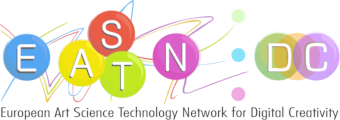Pay-off
This paper analyses the use of Immersive Experiences (IX) within artistic research, as an interdisciplinary environment between artistic, practice based research, visual pedagogies, social and cognitive sciences. This paper examines IX in the context of social shared spaces. It presents the Immersive Lab University of Malta (ILUM) interdisciplinary research project. ILUM has a dedicated, specific room, located at the Department of Digital Arts, Faculty of Media & Knowledge Sciences, at University of Malta, appropriately set-up with life size surround projection and surround sound so as to provide a number of viewers (located within the set-up) with an IX virtual reality environment. The set-up is scalable, portable and provide easy to use navigation and allow the user to move around within the virtual environment. The paper discusses how ILUM combines and integrates three research strands that are part of a major, sustained artistic or scientific focus of the partnering academic institutions, namely the Virtual Narration Lab (vnLab) at Lodz Filmschool, Poland, the Immersive Pipeline (IP) at Goldsmiths, University of London, UK, the ICST’s ‘Immersive Lab’ (IL) at the Zurich University of the Arts, Switzerland, and the Spatial Media Research Group (SMRG) at the National and Kapodistrian University of Athens, Greece. In those labs researchers, artists, film-makers investigate and create different kinds of IX. ILUM provides the opportunity to situate artistic research in the context of scientific. The thematic backgrounds of these research strands and the infrastructure of ILUM serve as starting points from which the partners collaboratively create new communication content, exhibition settings and research as well as teaching materials.
Abstract
The paper discusses how ILUM combines and integrates three research strands that are part of a major, sustained artistic or scientific focus of the partnering academic institutions, namely the Immersive Pipeline (IP) at Goldsmiths, University of London, UK, the ICST’s ‘Immersive Lab’ (IL) at the Zurich University of the Arts, Switzerland, and the Spatial Media Research Group (SMRG) at the National and Kapodistrian University of Athens, Greece. In those labs researchers, artists, film-makers investigate and create different kinds of IX. ILUM provides the opportunity to situate artistic research in the context of scientific. The thematic backgrounds of these research strands and the infrastructure of ILUM serve as starting points from which the partners collaboratively create new communication content, exhibition settings and teaching materials. Addressing the needs of the three target groups the paper will discuss:
1) The original development of the ILUM as being oriented towards practice-based research in Media Arts: Interdisciplinary Immersive Experiences within Media Arts. Through a multi-year development process with the Immersive Pipeline at Goldsmiths, University of London, the research group has acquired considerable expertise in IX Interactive Media, with a particular focus on surround sound (ambisonics/multichannel surround sound diffusion) and interactivity. This is applied to researching of generative, algorithmic, and media arts processes and the results will be shown to a general audience in public exhibitions.
2) The second scenario and field of expertise is established through collaborative work with ICST’s ‘Immersive Lab’ (IL) at the Zurich University of the Arts, Switzerland on Interdisciplinary Immersive Experiences within Cognitive Sciences. For the researchers, the key element is that the subjective experience can be challenged using new technologies and IX media that induce perceptual bodily illusions. Such illusions are interesting to study for cognitive neuro-scientific research of self-consciousness and provide an excellent way for communicating and explaining our scientific questions. Work in ILUM implements the experimental conditions for visitors to experience these bodily illusions and provides the public with a better understanding of the fundamental mechanisms of self-consciousness. The partner institutions have established contacts with cognitive scientists in their respective environment, so that this type of application provides an essential guide for further close collaboration across disciplines.
3) The third scenario is the application of techniques, tools, and processes of ILUM in Interdisciplinary Immersive Experiences within Social Sciences, such as Heritage Dissemination activities and finally an outlook on envisaged IX productions within migration studies. This enables immediate accessibility and provides direct experiences for general audiences that range from school-age children to adults. The ILUM researchers have the opportunity to retrace the process with a possible adaptation to the Maltese context. Crucial is that by bringing together images, sounds, and movement through interaction, an embodied relationship arises from reconstructed shapes of palaeolithic art and their synthesised movements. Critical points of development are the translation of heritage content into digital interaction modules, providing uninhibited access via animated media scenarios.
Back
“Reflections: Bridges between Technology and Culture, Physical and Virtual”
is supported by:






